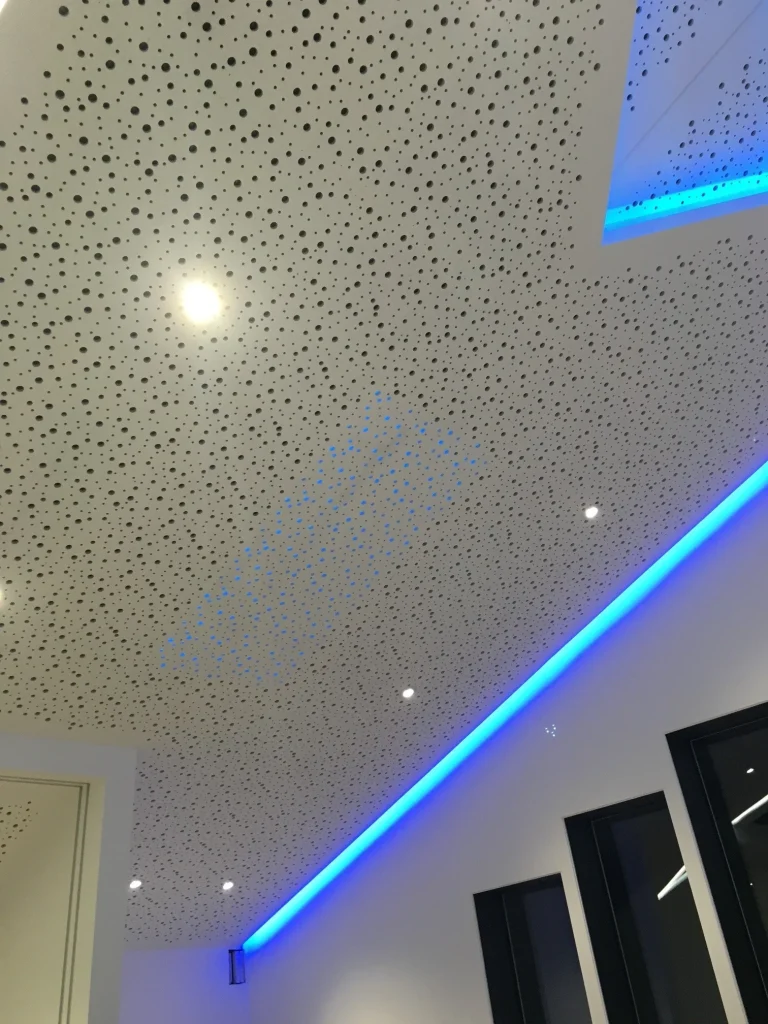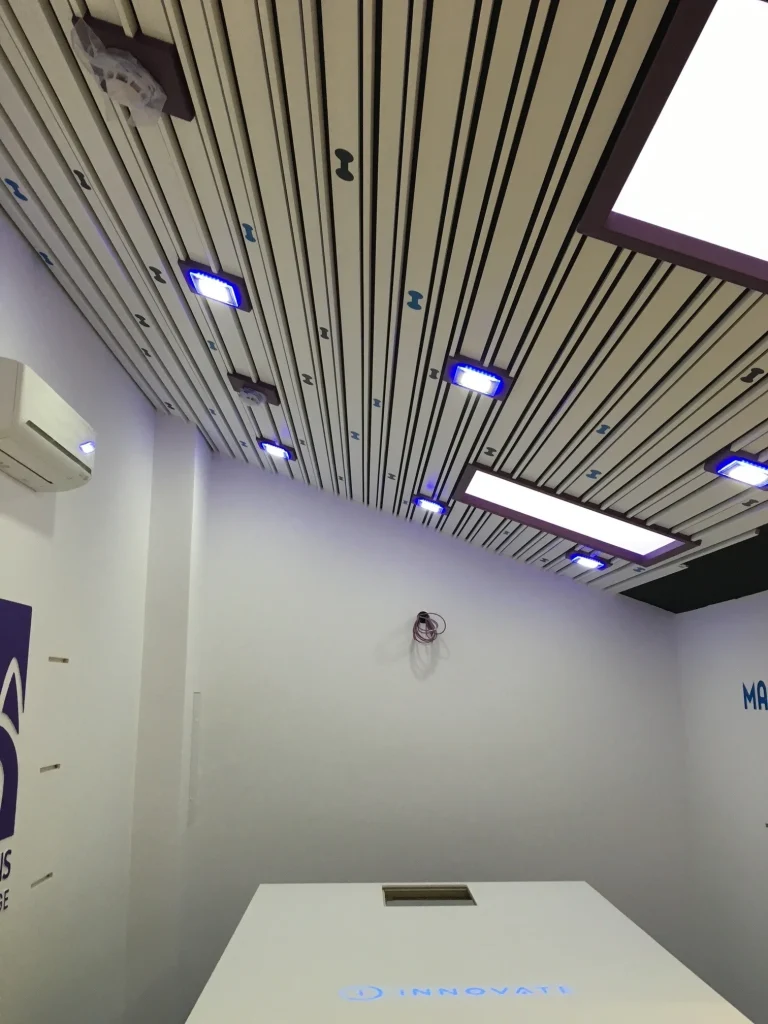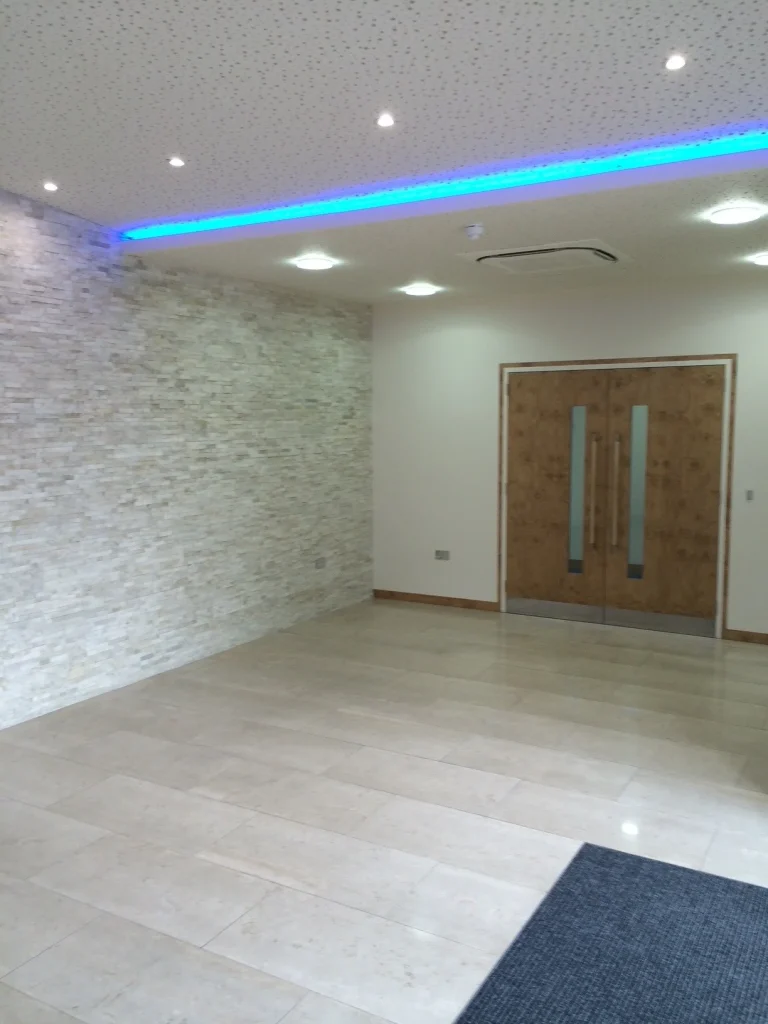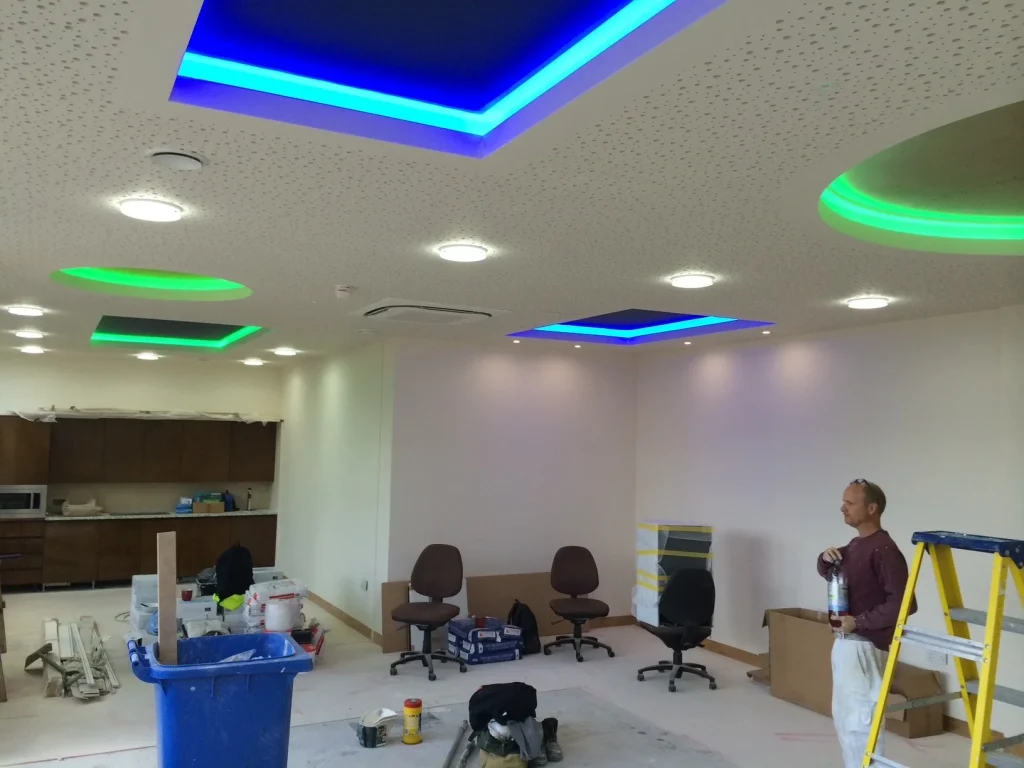Acoustic ceilings are a smart choice for improving sound quality in any space. They are designed to absorb sound, reducing noise and echo. This makes them ideal for both homes and commercial spaces.
These ceilings offer more than just sound absorption. They enhance privacy and comfort by minimising sound transmission.
Acoustic ceilings come in various styles, fitting any design preference. They can be integrated with other sound-absorbing elements for optimal results.
Whether for an open plan office or a cozy home, acoustic ceilings provide a practical solution. They create a more comfortable and productive environment.
What Are Acoustic Ceilings?
Acoustic ceilings are specially designed to reduce noise levels in indoor spaces. They consist of materials that absorb and dampen sound waves. This helps minimise echoes and reverberation in a room.
These ceilings improve room acoustics, enhancing the audio experience. They are popular in a variety of settings like homes, offices, and classrooms.
Common types of acoustic ceilings include:
- Ceiling tiles: Lightweight and easy to install
- Ceiling panels: Offer versatile design options
- Suspended ceilings: Ideal for covering ducts and wiring
How Acoustic Ceilings Work: The Science of Sound Absorption
Sound absorption is key in controlling noise. Acoustic ceilings work by absorbing sound energy through their material structure. The absorption minimises noise reflection, leading to a quieter environment.
These ceilings are crafted from materials that trap sound waves. The fibres or foam used in their construction dampen excessive noise. This reduces sound energy by converting it to heat.
Key materials and design elements that enhance sound absorption include:
- Porous surfaces: Allow sound waves to penetrate
- Fibrous or foam layers: Trap and dissipate sound energy
- Textured finishes: Break up sound wave patterns
Key Benefits of Acoustic Ceilings
Acoustic ceilings offer numerous advantages beyond sound control. They enhance the acoustic environment of any space, making it more conducive to daily activities. With reduced echo, conversations are clearer, leading to better communication.
These ceilings are adaptable to various settings, from homes to offices. They are not only functional but also contribute to the aesthetic appeal. Installation can easily be tailored to suit architectural styles.
Notable benefits of acoustic ceilings include:
- Sound absorption: Decreases noise levels significantly.
- Design versatility: Fits different decor schemes.
- Environmentally friendly options: Available in sustainable materials.
- Concealment capabilities: Hides wires and ductwork.
- Cost-effectiveness: Affordable sound control option.
These elements make acoustic ceilings a preferred choice. They enhance overall space quality while seamlessly blending with existing designs.
Enhanced Acoustic Performance in Open Plan and Commercial Spaces
Open plan and commercial spaces present unique acoustic challenges. Sound bounces off hard surfaces, amplifying noise. Acoustic ceilings are designed to absorb sound, reducing these issues effectively.
Commercial spaces benefit from improved sound clarity. Acoustic ceilings help in limiting noise travel, making environments more productive and focused. They work well in lobbies, offices, and open work areas.
Enhancements seen with acoustic ceilings include:
- Minimised echoes: Reduces sound waves bouncing off walls and ceilings.
- Improved speech intelligibility: Ensures conversations are understandable.
- Controlled noise levels: Maintains a calm, serene setting.
Such benefits prove valuable in busy environments. They transform chaotic spaces into areas of calm and concentration.
Improved Privacy and Comfort
Acoustic ceilings contribute to increased privacy. Sound absorption limits the extent to which conversations are overheard. This offers peace of mind in private or shared spaces.
The added comfort makes for an enjoyable atmosphere. Calm environments foster relaxation and enhance productivity. Features that boost privacy and comfort include:
- Sound insulation: Prevents noise travel between rooms.
- Private conversations: Maintains confidentiality in meetings.
- Relaxing ambience: Encourages a stress-free environment.
Improving these factors ensures spaces remain both private and comfortable.
Aesthetic and Design Flexibility
Acoustic ceilings provide aesthetic flexibility. Available in varied designs, they cater to different tastes. Whether traditional or modern, they match any decor seamlessly.
Design elements offer unique appeal. Patterns, colors, and materials contribute to visual interest. Benefits of this flexibility include:
- Customised finishes: Tailored to specific style requirements.
- Visual harmony: Blends well with other decor elements.
- Enhanced room design: Adds a touch of sophistication.
This versatility enhances both function and form, ideal for diverse spaces.
Energy Efficiency and Additional Advantages
Acoustic ceilings offer energy efficiency benefits. They provide insulation, helping to regulate temperatures. This reduces heating and cooling demands, lowering energy costs.
Additional advantages support sustainable practices. Many products are eco-friendly, contributing to responsible building choices. Key benefits include:
- Improved insulation: Enhances thermal efficiency.
- Sustainable options: Promotes green building standards.
- Reduced utility costs: Lowers energy consumption.
These advantages make acoustic ceilings both practical and eco-conscious.
Types of Acoustic Ceilings: Tiles, Panels, and Suspended Ceilings
Acoustic ceilings come in various types to suit different needs. Each type has unique characteristics and benefits. They enhance sound absorption while adding aesthetic appeal to spaces.
Common types include:
- Ceiling tiles: Easy to install, they fit into existing grid systems. Available in various styles and patterns, they enhance aesthetic value.
- Ceiling panels: Offer high sound absorption and can be integrated into any decor. Panels are versatile and easy to customise.
- Suspended ceilings: Popular for their functionality, they conceal wiring and ductwork. These ceilings provide excellent acoustic performance.
Choosing the right type depends on specific acoustic requirements and design preferences. All options offer effective sound control and design flexibility.
Integrating Acoustic Ceilings with Other Acoustic Solutions
Enhancing a room’s acoustics often requires combining different elements. Acoustic ceilings work best when used with other solutions. They are crucial in crafting a comprehensive sound-absorbing environment.
Consider integrating these elements:
- Wall panels: Improve sound absorption further by treating vertical surfaces.
- Flooring solutions: Carpets and mats can reduce noise reverberation.
- Furniture placement: Strategic placement helps in diffusing sound effectively.
Together, these elements provide holistic acoustic improvement for any space. Integrating multiple solutions ensures optimal sound control and a peaceful environment.
Installation and Maintenance: What to Expect
Acoustic ceilings are relatively simple to install. Proper installation ensures the best acoustic performance. It’s often best to consult professionals for installation.
Maintenance is straightforward and involves routine cleaning. Most acoustic ceiling products are designed for easy upkeep. This ensures long-lasting functionality.
Steps to consider:
- Professional installation: Offers precision and efficiency.
- Regular cleaning: Keeps panels dust-free for better performance.
- Periodic inspections: Helps to identify and resolve potential issues early.
Frequently Asked Questions About Acoustic Ceilings
Many wonder how acoustic ceilings perform. They are engineered to absorb sound waves effectively. Their design minimises noise and enhances clarity.
Questions about materials are common. Acoustic ceilings come in various materials, each with unique benefits. Materials can include fiberglass, foam, or mineral fiber.
People often ask about cost. Prices vary based on type and installation. Acoustic solutions can fit different budgets and needs.
Durability is a frequent inquiry. Acoustic ceiling products are built to last. They offer long-term acoustic solutions with minimal wear.
Key questions to consider:
- What materials are used?
- How do they enhance sound?
- What is the typical cost?
- How long do they last?
- Are they easy to clean?
Conclusion: Is an Acoustic Ceiling Right for Your Space?
Acoustic ceilings offer significant benefits for many environments. They improve sound quality and aesthetics, making spaces more comfortable. Whether it’s a home or commercial area, the impact is significant.
Assess your needs before deciding. Acoustic ceilings can transform noisy areas into serene havens. For those seeking better acoustics and design flexibility, they are a worthy investment.






